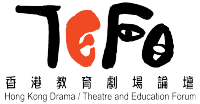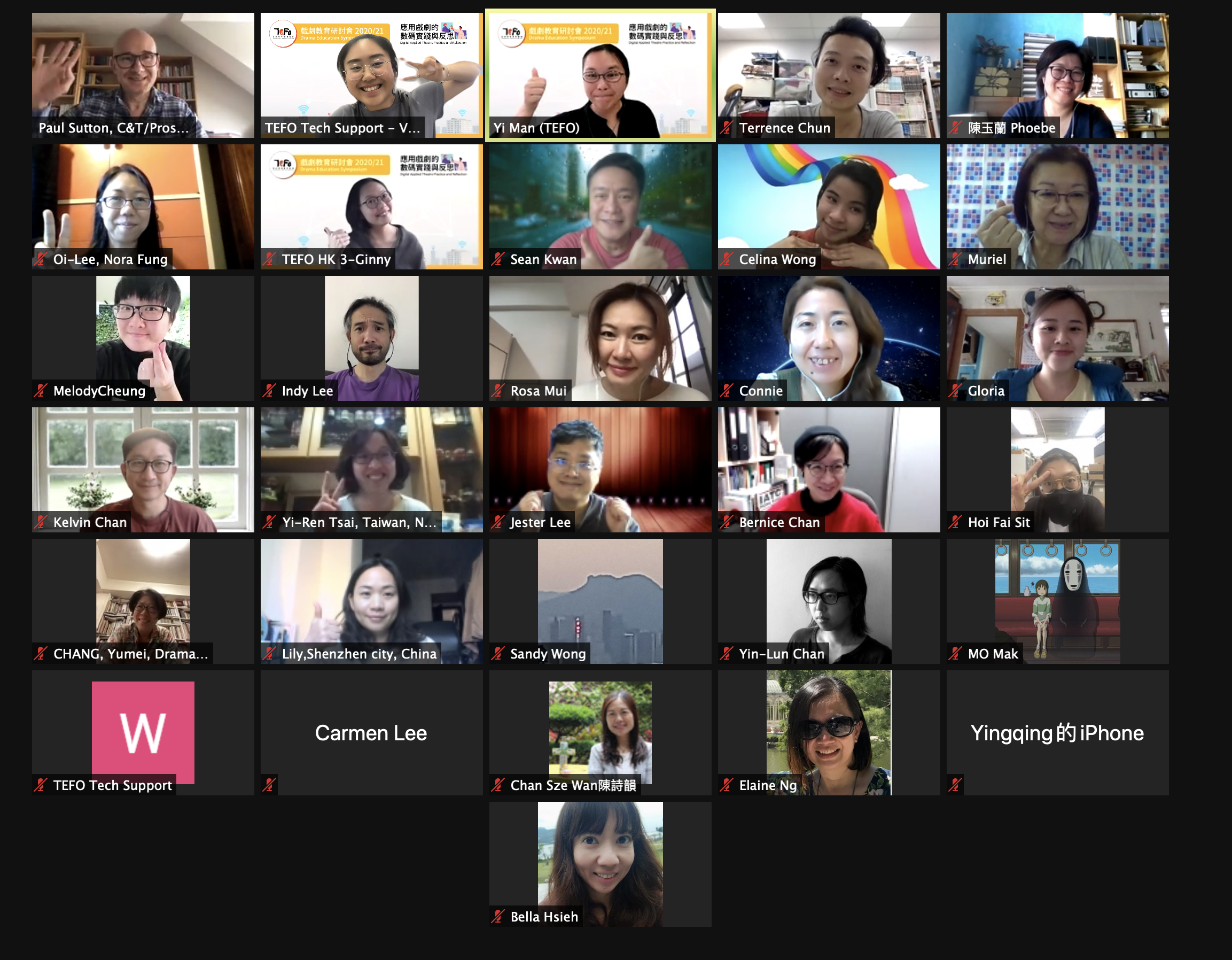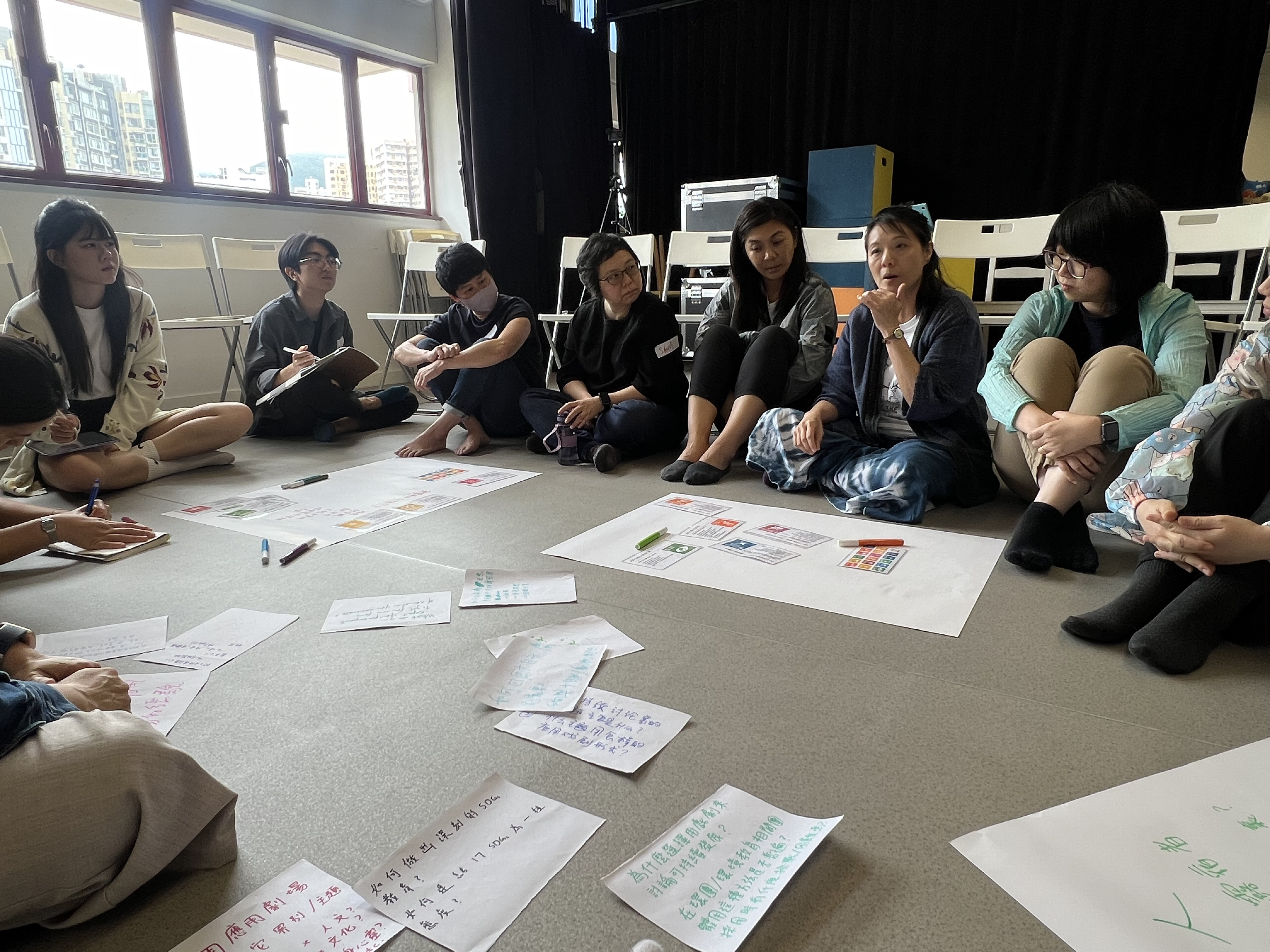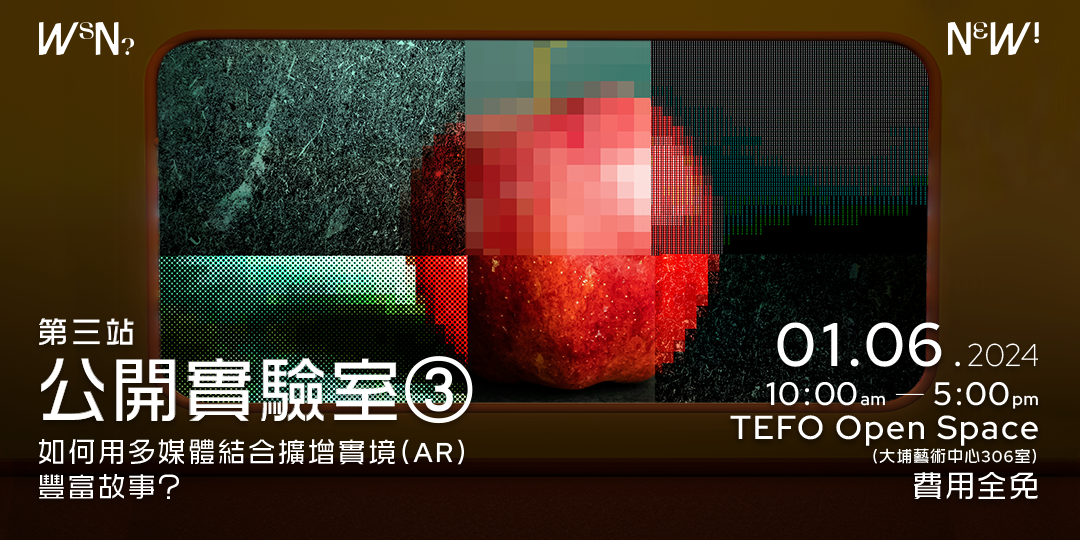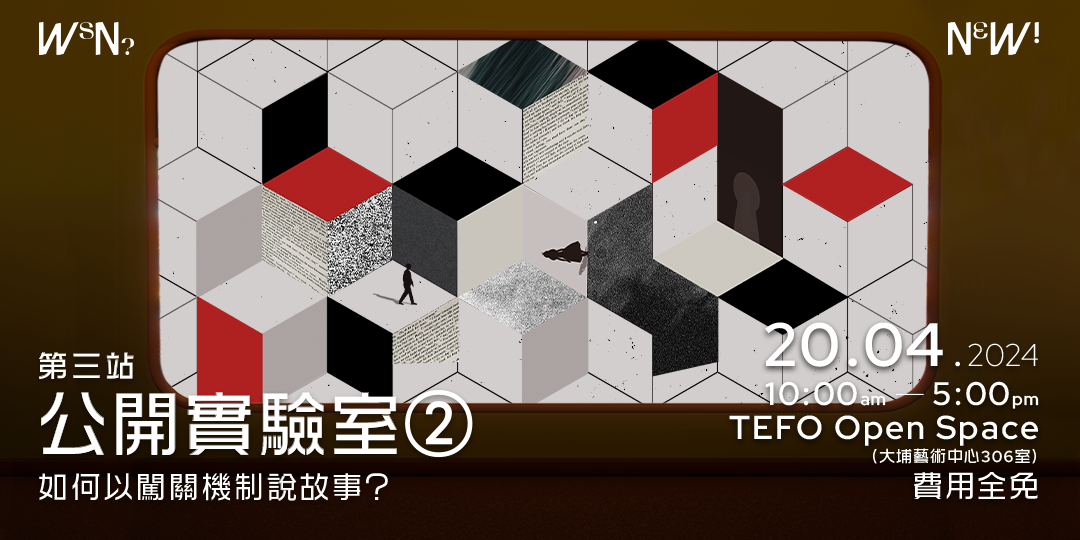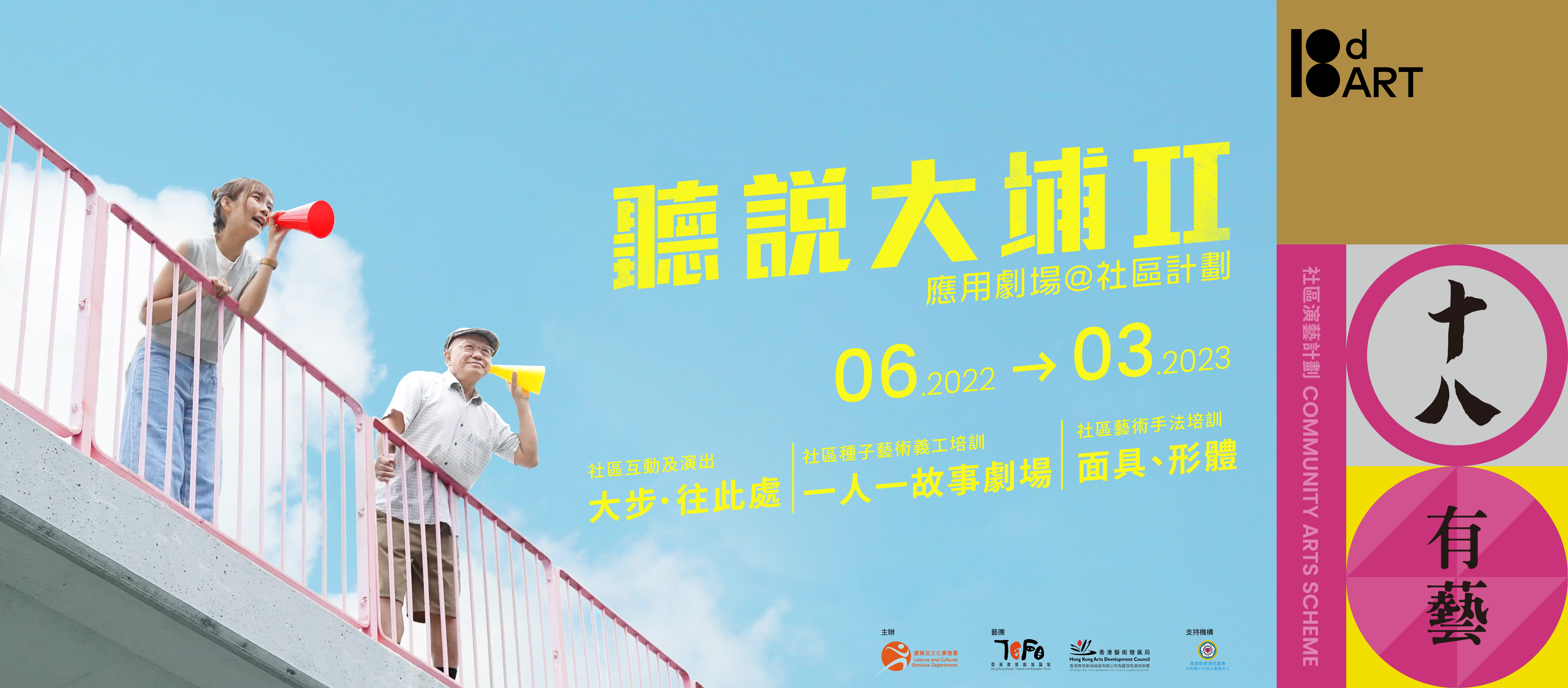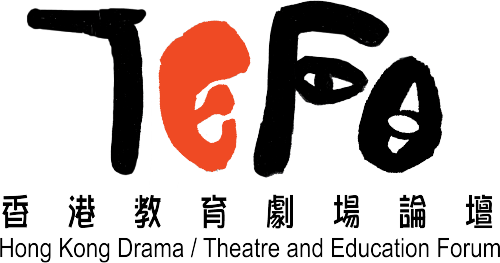「TEFO 戲劇教育研討會 2020/21」經已圓滿落幕!
TEFO 特邀當日的場地義工,撰文分享是此研討會的焦點內容:
【主題演講】
【網上互動工作坊】
從過程戲劇『小不點家庭』看線上應用劇場的『一樣?不一樣』
分享嘉賓:陳膺國 Kelvin Chan(兒童及應用劇場工作者)
而 TEFO 亦特別整理了在「開放空間」工作坊的想法和構思:
Playing with the Enablers: A Case Study of Creativity, Technology and Student Effectiveness
演講嘉賓:Prof. Michael Anderson (CREATE Centre, U of Sydney, Australia)
我們一直在思量創意、科技和教育如何與學生的能動力相交,促使學習發生。在疫情下,出現了一些對於科技與學習的有利及不利實踐。本主題演講將會討論到當學習者集體地及富想像力地投入到學習時,有什麼能構成一個有效地支援他們的「優質實踐」。我們也會談及到如何最有效地設計及運用科技於學習之中,亦會延伸分享到一個關於運用科技作為藝術工具的個案研究;以及展示一些給予學生進行集體創作的材料。
Written by: Gloria Lau
Since the beginning of the new millennium, technology has truly embedded itself into humanity. Smartphones act as bridges bringing people closer to each other; computers as tools for students to acquire knowledge. The big question is what awaits us even further into the future? In the education field, we can foresee in the short term, a pandemic-free environment where kids can finally go back to attending face-to-face classes, but how about even further away? How can educators reimagine and bring organizational change into education?
Our guest speaker Professor Michael Anderson introduced an important concept: the 4Cs, that could be embedded into any educator’s pedagogical approach that can better equip today’s learners. The 4Cs stands for Creativity, Collaboration, Communication and Critical reflection. Prof. Anderson was pointing out, as educators, it is vital to provide support for youths to understand the tools of creation, giving them greater power to reimagine and write their future. However, creativity isn’t just about “being creative”, rather it is a practice that believes in a mystical and unknowable creative process. This could be a tricky thought, the framework of creativity is not being creative, so how do we inspire creativity?
The model of the Creativity Cascade, can be used for teaching students of all ages, it encourages teens to observe, to notice the things around them. “You can’t create if you can’t notice what is going on in this world.” This sentence hit me hard during the presentation.
We have to ask ourselves, how can we integrate drama and technology into the learning process today? Not just using technology as an add-on or for aesthetic understanding like digital paint, but to use it as an artistic tool for creation; a way to bring the things we hold together in drama together. Technology doesn’t drive our process of learning, instead, we utilise it to lead and assist us both at the inside and outside of the classroom.
One of the greatest challenges I personally noticed is how can we encourage collaboration through virtual platforms like Zoom and computers. Producing an art piece with the use of technology is surprisingly clever, for example, musicians using AI as a collaborator to create music. Since technology provided us with the largest storage ever: pretext libraries, museums and digital online archives, it gives individuals more opportunities to create art by reshaping, rethinking the stories through critiquing them. It couldn’t have been successful if we were living in the past century, but now in the 21st century we can see the most substantial integration ever between drama, education and technology.
However, is that how things are going to be for us in the future? Shakespeare did not use Photoshop backdrops to create the greatest plays, will the future generation or kids that are born into technology create arts solely through some user-friendly online libraries? The answer towards this question is no, because there is another indispensable element we have to consider in this equation: playfulness. Teens playing around with different resources they have is the best way to invoke creativity. They get to explore the function and how these resources could create a narrative for them instead of just thinking about how to make a drama. On one hand, playing around may sound ineffective because individuals could spend so much time on just one simple part that they end up wasting their time and have nothing solid being produced. On the other hand, however, youths can figure out what is best for them through this process, actively choosing how to present the narrative of the story.
It is truly remarkable that sometimes we tend to forget the simplest way is the most effective way. Even though technology seems to be a cold hard wall that blocks human contact and redefines everything in our lives, Professor Anderson would argue that it is okay to use technology to enhance the learning process. As long as we don’t forget the basic element involved in drama education: playfulness, then technology can actually be a really intriguing new collaborator for individuals to create artwork that are unprecedented and shock the world.
How to Act Smart: Using C&T’s Prospero Technology to Inspire Learning Through Applied Theatre and Digital Technology
演講嘉賓:Dr. Paul Sutton (Artistic Director, C&T (Computers & Theatre))
21世紀是一個數位時代。新型冠狀病毒只是加速了我們對使用這些轉型科技的依賴。在這個主題演講中,講者會展示C&T的突破性數位平台Prospero,介紹它的急速發展與應用情況。憑藉過去30多年創作實踐及教學發展的經驗,Prospero在應用劇場和互聯網潛力之間建立了協同作用以促進創意學習。於疫情至今,全球有超過2,000間學校及團體使用該平台。講者將會分享Prospero的源起及演示它的各項供大眾可使用的功能,特別提及於網上數位圖書館中的一系列戲劇工作坊,舉例說明藝術家和社區團體如何運用這些網上資源擴展工作。最後,還會探討支持平台的道德和策展的變化動力;以及C&T如何努力地使Prospero能夠應對疫症後世界所面臨的挑戰。
Prospero: an online map of learning resources to extend our fingertips
Written by: Celina Wong
Paul Sutton is the artistic director at C&T, a Worcester, UK based company dedicated to researching into the methodologies to which mediated learning can occur. Their work intersects between kinesthetic learning and immersive technology, connecting communities and giving voice to unconventional ideas around the world through their platform. In this talk, Paul presented ‘Prospero’, a piece of technology that facilitates applied technology, including in applied theatre settings. Prospero focuses a lot on education, and the schools network that uses this technology is growing steadfastly. It has now been over a year since the COVID-19 pandemic struck, and the event has undoubtedly shaken the fundamental ways we experience human contact forever more. In a world where learning is now confined to a screen, how does Prospero answer the needs of students and education facilitators around the world?
Since 1988, C&T has been dedicated to the idea that drama and the arts are a way of knowing. In opposition to quantifying human experience into statistics and conventional testing, Paul comments that it is the “education sector’s myopia” in not valuing different truths. Truths that occur visually, through sound and other sensory means. The new generation has embraced technology as a way of overreaching and augmenting the human experience from the physical to the digital plane. C&T recognizes that to reach match this evolution, our teaching methods must too, grow digitally. In fact, Prospero was developed before the pandemic struck, a resounding evidence of how the company has been paying close attention the youth culture and the digital movement. They recognize that although the digital age has arrived, much of the world is underprivileged and lack necessary resources to invest in technology even though its values are evident. Thus, Prospero’s license and library is available at a range of prices, including some being completely free of charge, workable on any smart device including a mere phone. The proceeds are then reinvested into the toolkit for further updates, refinement, hoping to keep up with today’s ever changing internet.
So while the rest of the world asks, “How can we keep students in line?” Paul’s team at C&T has been asking, “How can we make the whole World Wide Web our stage?” Students around the world have lamented the lack of choices in their learning online. Online classrooms are at a tug-o-war competition for the students’ attention with the rest of the internet, many of which are underprepared to translate their lessons from physical to digital. The teachers are bound to releasing prerecorded materials, or else face the daunting task of bringing laggy connection to a fight of speed and social media. The idea which launched Prospero the application is much like the Prospero in Shakespeare’s The Tempest: to conjure and maneuver the digital world on the command of a ‘go’ button. Unlike other presentation tools in the market, Prospero’s platform appeals to all types of learners depending on what resources the creator implements into their scripted journey. Rather than a linear presentation, the application creates a map of online resources the facilitator would like the participants to experience at their own pace. This could be an interactive map, videos, images, recordings and activities — these could all be integrated together through Prospero’s ingenious Smartscript system. Liken to a flow chart, the creator can guide the participants of a workshop using Prospero, taking advantage of different applications, websites and resources available in the digital world.
Think of what ‘circle-time’ means in drama. Paul summarizes that “the circle is a democratic space for drama, so the web is for digital engagement”. A pre-recorded lecture is a speedy way to which the teacher or facilitator dominates the information flow, but pedagogically it makes little sense when learning can be so much more diverse. In giving time for students to participate in Prospero’s scripts, the students are given ownership to their learning. At the same time the media does not undermine the facilitator’s role to the script, just as a teacher is crucial to the rules of circle time. Paul emphasizes that though the creator must predict the students’ choices in the Smartscript, the facilitator can always edit, and add to the script freely. As more complex discussions arise, they also note that Prospero is working to accommodate these discussions in more authentic ways such as giving the participants the power of co-creation, a feature to debut in the near future.
To end the session, Paul invites us to check out the current Prospero library for inspiration on how to use the platform, and experience the potential it has for free. There are plenty of tutorials in the website for the creators to reference as they create their first Smartscript. Some notable uses of the platform includes a guided bike tour of the city of Birmingham (“ecoBirmingham”). It exploits the GPS function to track the participant’s location while seamlessly citing notable references around the city via the internet. Other intersecting media forms such as interactive comics implements digital art, and rehearsal techniques to be practiced at home for participants to role play as detectives (“The Dark Theatre 1, 2, 3, 4”). Feel free to experience these journeys at your own pace, but most important of all, enjoy and spread the change.
應用劇場線上變奏 靈活變通為關鍵
撰文:張彥雯
過程戲劇一般比較注重互動,由線下變成線上,需要作出甚麼調整,以打破空間和技術等限制?
是次工作坊雖然只有短短兩小時,但內容卻非常豐富。嘉賓陳膺國(Kelvin)首先跟大家玩簡單的熱身遊戲,也藉此分享主持線上活動的心得,例如活動開始時可以先問幾道是非題,請參加者以開啟/關閉鏡頭的方式或在聊天室以文字Yes/No作回應,破冰之餘,又可讓大家適應線上會議軟件的功能。
接著,Kelvin開始講解過程戲劇「小不點家庭」的創作緣由。「小不點家庭」靈感源自法國繪本《小不點交朋友》,利用角色人物和故事情節作為表達工具,讓特殊教育需要(SEN)孩子的家長發表心聲,紓緩壓力。「小不點家庭」首次在2013年以實體形式進行,並於今年初搬到線上,Kelvin發現某些環節比線下更逼真,而參加者可能更容易敞開心扉,訴說心底話。
Kelvin認為,線上活動即使遇到問題,都總會有解決方法。站在帶領者的角度,主持線上活動比較孤獨,溝通像是隔了一層紗,而且要有心理準備處理突發情況。像是當日工作坊的體驗環節,大家要一步一步製作小不點:首先用黑色紙張撕出小不點的形態,再創作小不點的性格和叫聲等。然而,部分參加者沒有黑色紙張,Kelvin就建議可用白紙和黑色顏色筆代替。
另一方面,相比起實體活動,參加者在線上的「決定權」比較大,他/她可以隨意控制自己的參與度,開啟/關閉鏡頭和麥克風,甚至加入或離開活動。帶領者除了要尊重參加者的選擇權,還需要變通,設法讓所有人同樣能夠參與其中。
工作坊帶來不少新想法,期待將來更多人參與應用劇場活動,發揮創意,變出各式各樣的精彩。
The Little Smudges Family
Written by Gloria Lau
“Playback is a key to memories,” Kelvin started the Symposium by walking us down memory lane with him, going back to how he started his first in-person Process Drama project for parents of special education needs (SEN). The play The Little Smudges Family was inspired by his favourite children’s book, Petite Tache by Lionel Le Néouanic. Lonely Little Smudge is searching everywhere for a friend and when it sees a group of shapes it felt excluded, and later went on a journey in search of its identity. The purpose of this project was to create a safe space for SEN parents to pour their hearts out and build a supportive community.
I personally find this project really special because the audience participates by acting out the story. One of the SEN parents said in one of the workshops, she really resonated with her character after participating the activities held by Kelvin. For a child, the entire world revolves around the question “Hey, can I join and play with you guys?” SEN kids are especially more sensitive to this, and therefore she finds this project really resonates with her.
Due to the pandemic, Kelvin is facing an unprecedented challenge: moving The Little Smudges Family to an online platform. Not only would the way of facilitating the Process Drama be different but also the logistics of it. Surprisingly, utilising technology like electronic devices was not concerning, but the different living environments of participants does have an impact on the level of their engagement. The process of emotional connection among the participants are also being affected by the Zoom breakout rooms because of the lack of physical presence and interactions. Without being in an environment where they were physically all together, how can participants feel involved? Therefore, Kelvin asked himself, how can he increase engagement in different ways while the only way is through the laptop screens and microphones? He made use of the Zoom functions to ask participants to feel with their eyes closed and speak at the same time. Most important part we can’t forget to mention, also the reason why participants are more prone to enjoy this way is they could feel the respect for their choices.
Compared to physical workshops, the SEN parents had the power and freedom to choose when and how much they were involved. Take camera and microphones as an example, if they don’t feel comfortable there is always the choice to leave the camera off and the microphone on so at least there is some level of involvement. Even though getting all of them to actively respond can take time, the crucial element here that does make a difference that could possibly impact on parents’ reaction is the feeling that their voices are being respected.
Emotional connection between participants as I mentioned before, is part of the essential puzzle that cannot be erased from the Process Drama and yet the most challenging element that requires effort. In order to move the play to the virtual world just by changing the way we present it instead of the core content, we could be facing lots of technical problems. However, the challenges that Kelvin faced could also lead to a new and major breakthroughs to bring Process Drama online.
After the COVID-19 pandemic phases out, this could be a new way to present stories instead of just a temporary solution. As one of the participants of this online version of The Little Smudges Family I would say it was a success for me to really connect with the others. At first, I was really worried that it would be awkward for me to participate and speak. Later on, because I get to turn off my camera and still participate, I generated some courage to speak up, contributed to the discussion. It was probably the best Zoom experiences I have ever had comparing to my university tutorials. Kelvin was brilliant in weighing all the concerns and producing this version of The Little Smudges Family. This could really be the very first interactive play I have been to that I really enjoyed immensely.
劇場遊戲線上探索
遊戲帶領者:劇場遊戲博物館團隊
線上劇場遊戲 跳出有形無形框框
撰文:張彥雯
傳統劇場遊戲牽涉走動和群體互動,線上形式可以怎樣做到?工作坊透過體驗和討論,與參加者探索線上劇場遊戲的挑戰與可能。
是次工作坊設有廣東話、普通話及英語三場,讓參加者以熟悉的語言參與,更容易投入。筆者參加的廣東話場約有九位參加者,有人用電腦、有人用電話、有人在戶外……帶領者Ginny首先了解大家的情況,並建議不方便開啟鏡頭和麥克風的參加者使用聊天室。
大家簡單自我介紹後,就開始遊戲「動作放大器」:參加者要一個接一個以較誇張的手法重複前一位參加者的動作。線上進行這個遊戲,可以利用「開啟/關閉鏡頭」功能,請參加者陸續「亮相」,熟習鏡頭和空間遠近的運用。
接下來是遊戲「Bottle is not a bottle」,參加者只需自備一個水瓶,將水瓶幻想成另一件物品(如望遠鏡),其他參加者可以加上情境描述,即時互動創作。傳統實體遊戲會傳遞水瓶,建立參加者之間的連繫,而線上的話,只要大家發揮想像力「拋接」水瓶,亦能做到類似效果。
將劇場遊戲搬到線上,未必弊多於利。舉例說,工作坊其中一個環節要求參加者選一個虛擬背景,開始時一位參加者按虛擬場景自行創作演出,其他參加者為「演員」配音或描述情節發展。就筆者所觀察,帶領者善用線上會議軟件「開啟/關閉鏡頭和麥克風」、「虛擬背景」、「spotlight」及「畫廊視圖(Gallery View)」等功能,提升了參加者的觀察力、專注力和創造力。
當然,線上形式的一大挑戰,是大家對軟件的熟悉程度不一,容易遇到技術問題。就像剛剛提到的環節,當「虛擬背景」效果不似預期,可以怎樣做?當日大家也有討論這個問題,並認為帶領者介入提出建議前,可以先徵詢大家意見,看看如何將出乎意料的情況合理化。這做法既可讓活動繼續進行,又不會影響參加者參與的機會。
劇場遊戲轉為線上形式難免受硬件和軟件限制,但大家只要發揮創意,亦可跳出框框,突破界限,創出無限可能。
A conversation about how to maximize the experience of dramatic techniques on Zoom
Written by Celina Wong
What differs theatre games from generic games? What makes the game ‘theatrical’ and what are some challenges facilitators may face while translating all of this to a digital format? These are some of the questions we attempted to answer during our session of playing seriously as an eclectic group comes together online on Zoom. Perhaps the nearest application of a theatre game would be in a classroom, yet our group was a little more diverse. Some participants came from a landscaping background with an interest in how digital projections can interact with found space, some had more experience in drama and acting — all of which added interesting dimensions to our discussion after the games.
Our facilitator, Valerie, had an infectious energy which made the event run by a lot quicker than anticipated. We were told the games were not finalized in this version of the workshop, and we were getting a taste of what it could be, but she looked forward to our input and opinions at the end of the experience. First, she opened the space by inviting us to introduce ourselves and the story behind our chosen water bottle to bring to this call. Immediately this allows us to bring some authenticity and background into our virtual Zoom boxes, and it allowed the participants in the game to feel a little more connected to each other via our personal stories. With this bottle, we played “Pass the bottle” around the circle. The idea is to use our creativity and transform the tangle prop into something imaginative — a telescope, a paddle on a river and more! We noted how the game was gestural and the frame of the digital format actually gave some boundaries, and acted as a creative construct for the game participants to work with. For example, as the lower body was restricted from sight, the gestures used to make the bottle into a paddle became a lot more effective and interesting to view. Albeit, there were some technical difficulties including how not everyone’s version of the application was the same, thus the sequencing part of the circle was given up. Instead, we called the name of the person we wanted to pass towards. This segment echoed our real life experiences working with technology, especially the disparity of resources with the people we work with can create some boundaries to how we can realistically design and implement theatre games.
One part of theatre games that differs from other games is the value of imagination, interaction with space and collaboration. Valerie noted that the virtual background is something applied theatre formats could explore as a way to connect different spaces together online. Individually, the participants had prepared an array of images for our virtual backgrounds for this part. As the spotlight was given to one participant interacting and playing with their virtual space, the other participants were tasked to create sound effects to aid the performance. Some participants found that their device did not fully support the feature and their faces were somewhat obstructed, but we were able to use these to make abstract or unconventional choices. One participant had much of their face blackened out and chose to make a witchy scene, displaying an interesting interaction between creativity and technology. Other participants noted that flat spaces were harder to create with in contrast to pictures with depth, because it creates more possibility in the frame. Teachers in the group noted that the atmosphere virtual backgrounds are useful in offering a chance in the group sharing a planned atmosphere. Meanwhile, some noted that having participants actively participate using their webcams is also a fundamental challenge to overcome when facilitating activities online. Using atmospheric prompts such as the virtual background is a great tool to encourage active participation, emphasizing on shortening the distance in distance learning, these tools help cultivate ‘togetherness’ in an otherwise cold, removed environment. This can make it easier to engage students in activities, especially when everyone has an assigned role in the project which has the potential of being recorded.
Another feedback to the whole workshop related to the programming of the events. Many participants resonated with how virtual prompts are a great way in aiding expression online and thus, was an easier way into warming up to using our bodies as the main expressive tool. Contrary to in-person facilitation where simple, verbal prompts for imagination would be used for warm-ups, the digital space calls for different prompts. As a group, we found that facilitation online definitely has its limitations, but to make it work, we must take more awareness to what the tool may offer. How can we maximize the resources available to us — sound, framing, visual effects… how can these inform our perception and our experience of theatre from here on out?
觀看我們的 Padlet,閱讀每項討論主題的筆記!
https://padlet.com/tefo/vsj1mc5hdjh2eyxo
Day 1 討論主題:
- How do we deliver Playback online?
- Digital Applied Theatre and Urban Space
- 網上應用劇場的經驗如何延伸到未來實體的發展?
Day 2 討論主題:
- 網上應用劇場的經驗如何延伸到未來實體的發展?(Cont’d)
- 跨領域的創作點搞呀?
- Uses of Prospero
- 怎樣有效地利用戲劇及在線的方式帶動成人在職場上的發展?
標籤:
